Kerala Plus Two Macroeconomics Chapter Wise Previous Questions Chapter 4 Income Determination
Question 1.
Classify the following statements into two branches of economics: (MARCH-2008)
a) Firm’s decision about how much to invest.
b) Govt, has adopted devaluation to overcome deficit in balance of payments.
c) RBI has increased Cash Reserve Ratio to control inflation.
d) Price elasticity of luxury good is elastic
Answer:
a) Micro economics
b) Macroeconomics
c) Macroeconomics
d) Microeconomics
Question 2.
Assume the marginal propensity to consume of a State in India is 0.8 (MARCH-2010)
1) Find out tax multiplier and expenditure multiplier.
2) From the above example prove that adding these
two policy multiplier brings balanced budget multiplier.
Answer:

Question 3.
Suppose income of individual A increase from ₹1,000 to ₹1,100. So his consumption rises from ₹750 to ₹825. Find out MPS and MPC. (MARCH-2010)
Answer:

Question 4.
a) Complete the following table: (JUNE-2010)
–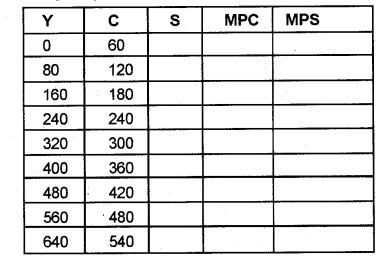
b) Using the equation prove that MPC + MPS = 1
Answer:
a)
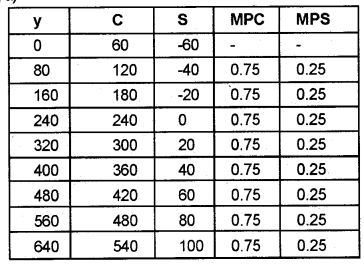
b) MPC + MPS = 1
That is 0.75+ 0.25 = 1
Question 5.
The Central Government sanctioned ₹40 crores to Kerala and Assam for making additional investments. The MPC of Kerala is 0.8 and Assam is 0.5. (JUNE-2010)
a) Find the multiplier and multiplier effect on income of these two States.
b) Explain the concept output multiplier.
Answer:
a)
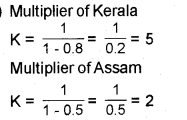

= 80 crores
b) Multiplier denotes the relationship between investment and income. Increase in investment leads to increase in income.
Question 6.
A = C + T = ₹ 50 crores, MPC = 0.8, Y = ₹ 4000 crores (MARCH-2011)
a) State whether the economy has reached in equilibrium or not (Hint: Y = + CY)
b) Illustrate your conclusion in a diagram.
Answer:
Y = + c. y
Since = . we have
Y = x c. y Putting values, we get
Y = 50 + 0.8 x 4000
=50 + 3200 – 3250
Since 3250 ≠ 4000, equilibrium is not reached in the economy.
Question 7.
Multiplier plays a significant role in Keynesian Macro Economics. (MARCH-2011)
a) Examine the relationship between multiplier and MPC
b) If MPC = 0.8, calculate multiplier.
Answer:
a) The value of multiplier is determined by marginal propensity to consume. Higher the MPC, greater the size of multiplier lower the MPC, smaller the size of multiplier. When income of consumer rises they spend more the value of increase in income ie. multiplier depends on’MPC, greater the value of multiplier depends on greater size of MPC. Thus there is direct relation between multiplier and MPC.
The relation can be expressed in terms of an equation as under

Putting the value of in equation we get,
![]()
Thus it is clear from the above equation that the value of MPC and multiplier are positively related
b) MPC = 0.8

Question 8.
Distinguish the terms ‘Ex ante investment’ and ‘Ex post’ investment. (MARCH-2012)
Answer:
Ex ante means ‘anticipated’ while Ex post means realised. In economics ex ante investment refers to anticipated investment in an economy while ex post investment refers to the realised investment.
Ex ante: The planned value of a variable as opposed to its actual value.
Ex post: The actual or realized value of a variable as opposed to its planned value .
Ex ante consumption: The value of planned consumption
Ex ante investment: The value of planned investment.
Question 9.
Explain the concept of aggregate demand with the help of a diagram.(MARCH-2013)
Answer:
The total amount of goods and services demanded in the economy at a given overall price level and in a given time period. It is represented by the aggregate-demand curve, which describes the relationship between price levels and the quantity of output that firms are willing to provide. Normally there is a negative relationship between aggregate demand and the price level. Also known as Total spending”.
Aggregate demand is the demand for the gross domestic product (GDP) of a country, and is represented by this formula:
Aggregate Demand (AD) = C + I + G + (X-M) Where, C = Consumers’ expenditures on goods and services.
I = Investment spending by companies on capital goods.
G = Government expenditures on publicly provided goods and services.
X = Exports of goods and services.
M = Imports of goods and services.
Downward sloping aggregate demand curve
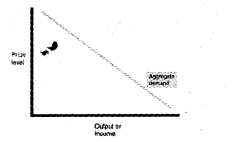
The most noticeable feature of the aggregate demand curve is that it is downward sloping, as seen in . There are a number of reasons for this relationship. Recall that a downward sloping aggregate demand curve means that as the price level drops, the quantity of output demanded increases. Similarly, as the price level drops, the national income increases. There are three basic reasons for the downward sloping aggregate demand curve. These are Pigou’s wealth effect, Keynes’s interest-rate effect, and Mundell- Fleming’s exchange-rate effect. These three reasons for the downward sloping aggregate demand curve are distinct, yet they work together.
The first reason for the downward slope of the aggregate demand curve is Pigou’s wealth effect. The second reason for the downward slope of the aggregate demand curve is Keynes’s interest-rate effect. The third reason for the downward slope of the aggregate demand curve is Mundell-Fleming’s exchange-rate effect.
Question 10.
Distinguish the concepts (JUNE-2014)
a) Ex Ante and
b) Ex Post
Answer:
Ex-ante and Ex-post
Consumption, savings and investment can be classified into Ex-ante and Ex-post variables. The terms Ex-ante and Ex-post have been derived from the Latin word. Ex-ante means planned or desired. Ex-post means actual or realized. In national income accounting, the variables such as consumption, investment and savings are considered as ex-post variables. The rate at which consumption, savings and investment are presented in the ex-post sense.
Question 11.
Explain the concept marginal propensity to consume. How it relates to marginal propensity to save? (JUNE-2014)
Answer:
Marginal Propensity To Consume – MPC’
The proportion of an aggregate raise in pay that a consumer spends on the consumption of goods and services, as opposed to saving it. Marginal propensity
to consume is a component of Keynesian macroeconomic theory and is calculated as the change in consumption divided by the change in income. MPC is depicted by a consumption line- a sloped line created by plotting change in consumption on the vertical y axis and change in income on the horizontal x axis.
The marginal propensity to consume (MPC) is equal to AC / AY, where Ac is change in consumption, and AY is change in income.
Marginal Propensity to consume refers to the ratio of change in consumption to change in income. MPC = AC / AY
Marginal Propensity to save refers to the ratio of change in saving to change in income.
MPS = AS /AY
The sum of MPC and MPS is always one and equal to unity.
That is MPC + MPS = 1
Question 12.
The point on the supply curve at which a firm earns normal profit is called _________ (MARCH-2015)
a) Normal profit
b) Super normal profit
c) Break-even point
d) Shut-down point
Answer:
d) Shut-down point
Question 13.
In an economy, investment increases by 500 crores. If MPC is 0.5, what is the increase in total income? (MARCH-2015)
Answer:

Increase in total income
= Kx increase in investment
= 2 x 500 crores
= 1000 crores
Question 14.
If all the people of the economy increases the proportion of income they save, the aggregate savings in the economy will not increase. This phenomenon is known as ______. (MARCH-2015)
a) Paradox of prosperity
b) Paradox of thrift
c) Leontief paradox
d) Giffen paradox
Answer:
Paradox of thrift
Question 15.
Study the following table and answer the questions. (MARCH-2015)

a) Derive the aggregate demand schedule.
b) Show graphically the components of aggregate demand.
Answer:
a) Aggregate desired schedule
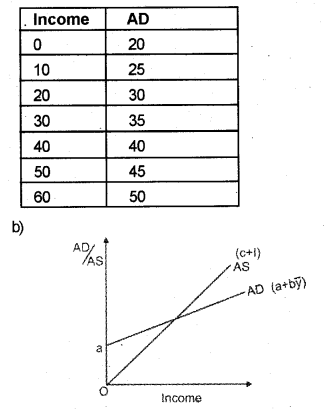
Question 16.
a) Explain Effective Demand. (MAY-2015)
b) What are the determinants of the value of aggregate demand?
c) Diagrammatically explain the change in Aggregate demand due to a change in government expenditure.
Answer:
Effective Demand
a) The logical starting point of Keynes General Theory is the principle of effective demand. Effective demand is the aggregate demand for the existing output at prevailing prices. The main reason for unemployment in an economy is the deficiency in aggregate demand. To avoid unemployment, we have to increase effective demand. Income and Employment determination The level of income and employment will be determined at the point where aggregate demand equals aggregate supply.
b) Aggregate demand and its determinants Aggregate demand is the total demand in an economy at various levels of employment. In other words it is aggregate expenditure on all goods and services in the economy. It consists of the four components.
They are:
- Consumption demand
- Investment demand
- Government demand
c) Equilibrium level of income is determined by Aggregate demand (AD) and Aggregate Supply (AS). This situation is shown in figure 1.
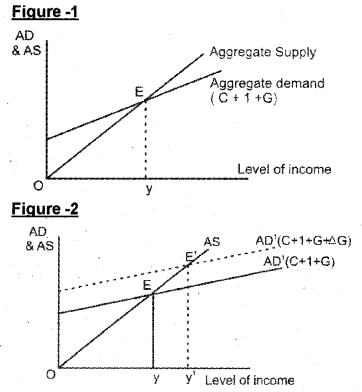
Figure 2 shows the effect of change in government expenditure. As government expenditure increases AD curve shifts up to AD1.This brings new equilibrium point at E1. So the level of income increases to Y1.
Question 17.
Distinguish between the terms Ex-ante Investment and Ex-post Investment. (MAY-2016)
Answer:
Ex-ante investment means planned investment. On the other hand, ex-post investment means actual or realised investment.
Question 18.
Consider the following diagram. Answer the following questions: (MARCH-2017)
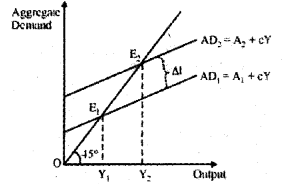
i) What does the 45° line represent?
ii) What is the difference between A1 and A1?
iii) List two possible reasons for an increase in Autonomous Expenditure.
iv) When the economy moved from E1 to E2, the Aggregate output is increased more as compared to Aggregate expenditure. Why?
v) Explain the movement of the economy from E1 to E2.
Answer:
i) Equilibrium income determination curve (AD curve)
ii) When investment increases the aggregate demand will increase. So equilibrium income will also increase.
iii) To increase public expenditure of govt.
To increase transfer of payment of govt.
iv) When govt, expenditure increases there occurs a change in autonomous component of the aggregate demand curve. The slope will remain constant then equilibrium income will increase. This is due to the operation of the multiplier.
Suppose the govt, expenditure increases, then aggregate demand curve shift from AD1 to AD2. So equilibrium income increase form E1 to E2. The change in income (∆y) is greater than change in govt, expenditure (∆G). This is due to the effect of multiplier.
Question 19.
Among the following choose the one which represents the multiplier. (MARCH-2017)
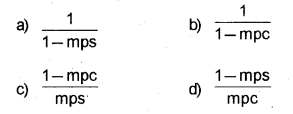
Answer:
![]()
Question 20.
Elucidate the working of Autonomous Expenditure Multiplier Mechanism with a suitable example. Show the impact of a decline in MPC on multiplier. (MARCH-2017)
Answer:
Consumption at zero level of income is called autonomous consumption. When there is increase in autonomous expenditure, the aggregate demand curve shifts upward. Similarly, when there is fall in autonomous expenditure the curve shifts downward.

Here mpc is the decisive factor influencing the value of multiplier. For example, if the value of mpc is 0.75, the multiplier is

